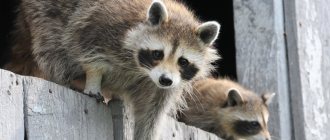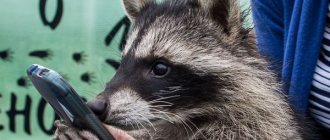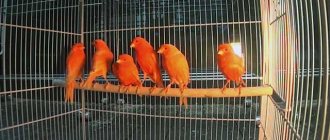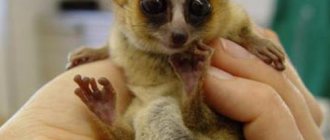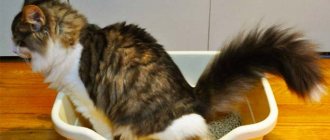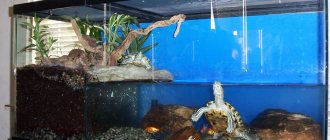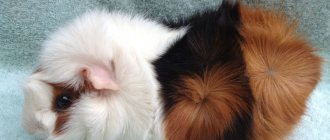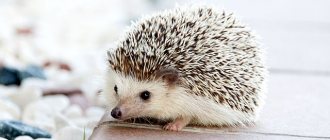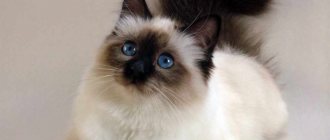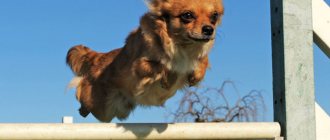09/24/2020 Scientist cat Animals
The striped raccoon is a very interesting and funny animal. It is interesting not only to scientists, but also to ordinary people. For example, it is useful to know what raccoons eat, whether they can be kept at home, and how long they live. To answer these questions, you need to read this article.
Eating in the wild
By nature, raccoons are absolutely omnivorous. Life in the wild provides the opportunity for animals to eat:
- snakes;
- insects;
- mice;
- lizards;
- other rodents;
- frogs;
- crayfish;
- acorns;
- berries;
- bird eggs;
- turtles;
- fish;
- wild fruits;
- nuts.
In order to get food, the animal can go up to two kilometers from its home. In the wild, notes settle in abandoned holes or climb into hollow trees.
The peak activity of mammals occurs at night. Tenacious paws allow you to climb trees perfectly and hold various objects firmly in your paws.
Raccoons living in close proximity to human habitation eat everything they can find: trash, pizza, chips, soda water and other delicacies.
Raccoon lifestyle
Raccoons are very friendly animals, but they prefer to lead a solitary lifestyle. The only exception may be the winter hibernation period, when several animals often fall asleep in one shelter at once. Raccoons do not show aggression towards their neighbors. Even if one animal finds itself in the territory of another, the animals do not quarrel with each other (provided that one raccoon does not pretend to occupy the lair of its relative). The feeding areas of predators often overlap.
Raccoons communicate with each other using different sounds - rumbling, chirping, squealing, whistling. Often in places where there is a lot of food, animals form dense settlements. In America, up to 100 raccoons can live on an area of 1000 hectares, and in protected parks on such an area - up to 300 individuals.
These animals lead a predominantly twilight-nocturnal lifestyle, during the daytime they sleep in their shelters, resting in hollows and on tree branches. Those raccoons that settle in coastal areas adapt their sleep to the time of low tide. In search of food, the animals walk around an area up to 3 kilometers in diameter. Predators try not to leave their areas.
Interesting fact
When a raccoon is in mortal danger, and it is impossible to escape or hide, it pretends to be dead. This trick often saves a predator's life. But if the technique does not work, the animal starts to fight.
Raccoons are distinguished by their intelligence and easy adaptation to environmental conditions. They climb well, get to the tops of trees very deftly and can descend from a height even head first. This is possible thanks to the highly mobile feet that rotate 180 degrees. Raccoons usually walk on the ground with measured steps, but if necessary they can run, reaching speeds of up to 24 kilometers per hour.
Raccoons receive the bulk of information about the world around them thanks to their developed sense of touch. In addition, they have keen hearing and excellent vision. These predators move confidently in the dark and swim well.
Raccoons living in the south are active throughout the year, but animals that live in the north may not leave the den for weeks at sub-zero temperatures. All this time the animals sleep, but since the metabolic processes in the body and the heart rate do not slow down much, and the body temperature does not decrease, this state cannot be called real hibernation.
The duration of shallow sleep directly depends on the cold weather. Canadian raccoons sleep the longest - about 4-5 months. In the southern part of the North American continent, striped raccoons do not sleep at all. Animals simply wait out the period of snowfalls without leaving the shelter. It is noteworthy that raccoons can wait out bad weather in one den in entire groups.
Feeding raccoons at home
In order to understand what to feed raccoons in captivity, you need to learn about the way these fascinating creatures feed in the wild. The diet should not only be balanced, but also healthy. Do not forget that raccoons are predatory animals.
Regardless of the type of animal - striper or albino, the raccoon eats everything. That is why the animal should definitely enjoy the following types of protein foods as homemade meals:
- meat;
- milk;
- seafood;
- bird;
- eggs.
Gargles simply adore plant food. It is very common to see a raccoon eating grapes, cherries, olives or bananas. In addition to the listed delicacies, gargles will gladly accept for lunch:
- vegetables: melons, zucchini, pumpkin.
- nuts: hazelnuts, pistachios, walnuts, almonds.
- berries: strawberries, grapes, mulberries, gooseberries.
- cereals: buckwheat, rice, corn and rolled oats.
During the cold season, raccoons very often need dried fruits. Often, owners give their pets dry formula for other pets (dogs or cats).
Who is a raccoon
This predatory mammal is the size of a medium-sized dog and belongs to the raccoon family. The striped raccoon (Procyon lotor) is native to Central and North America and came to Europe at the beginning of the 20th century. The nimble animal is found in many parts of the planet, including the North Caucasus and the Far East. The animal is nocturnal and hides during the day. For housing, raccoons choose hollows, other people's holes, or small structures made from tree branches, which they “steal” from other animals. They breed in early spring.
What does it look like
The striped raccoon (or American raccoon) is a touching creature that looks like a dog or a fox. A medium-sized predator (weight from 6 to 9 kg, a well-fed animal reaches 16 kg), body length: 50–60 cm, tail on average 25 cm. Males are larger than females, with a strong and stocky body. The appearance has the following features:
- Head. The muzzle is wide, pointed, reminiscent of a mask (the illusion is created by the color: there is white fur around the black nose, the area of the eye sockets and forehead is also black, around the eyes there are wide black lines with a white edging that stretch to the neck), the ears are small and rounded.
- Limbs. Short, but the fingers are well developed. The paw is similar to a human hand: there are no partitions between the fingers and fine motor skills are well developed. These properties help the animal handle small parts well. There are videos on the Internet of how cunning people open cans of beer and sneak into refrigerators. The toe ends in a pointed long claw so that they can climb trees to the top.
- Feet. Movable, rotate 180 degrees. This physiological feature allows the animals to somersault and perform tricks in trees.
- Wool. Thick, different in length on different parts of the body, longer on both sides of the head ("tanks" are formed). Color: gray-brown. The undercoat is dense.
- Tail. Fluffy, with dark brown or black rings, of which there are up to 10 pieces.
Habitat
The striped raccoon prefers to settle in a mixed forest (avoids conifers). Animals cannot survive without water, so there will definitely be a river, swamp or lake near their habitat. The striped raccoon likes to make its “homes” at a height of 20-30 meters above the ground, in hollows. Individuals living in the southern regions often make their home on the coast. The animal is not shy, so it settles near the city. In the United States, predators are raiding farms in the suburbs, and this is a problem for local residents who are at war with the animals.
Distribution area
The striped raccoon comes from North America, where it still lives from the Isthmus of Panama to the southern provinces of Canada. Predators were introduced to Europe and Asia in the 20th century. The striper has acclimatized in the forests of Azerbaijan, Belarus (Polesie), on the islands of the East Indies, Germany, France and the Netherlands. Baby stripers were brought to the USSR in 1936, where they took root. Animals are found in the Far East and the Caucasus.
Principles of nutrition
With the onset of dusk in the wild, striped raccoons go hunting. At home, it is enough to follow the correct diet:
- before bed;
- in the evening – 7 o’clock;
- at night - at 11 o'clock.
On the Internet, you can often see videos of raccoons eating cake, pancakes, plums or olives. The animal will always ask its owner for something tasty.
Improper feeding can lead to excess weight gain and intestinal problems. Domestic raccoons generally do not hibernate.
Seasonal feeding
The diet changes noticeably during periods of hibernation not only among wild, but also among domestic raccoons:
- with the onset of autumn cold weather, the animals noticeably gain weight and constantly want to eat;
- Winter cold does not become an obstacle in the life of domestic gargles, but the activity of the animals is noticeably reduced. Thus, the owner reduces the diet by half;
- the warm season literally awakens pets and promotes metabolic activation;
- Summer is a great time to indulge in a wide variety of delicacies.
Feeding the young
Depending on age, the diet for young animals follows some recommendations:
- Puppies up to 1.5 months. Babies require special attention. They need to eat not only during the day, but also at night every three to four hours. After each meal, the owner should monitor the puppy's health and give him a tummy massage. Breeders feed one-month-old raccoon puppies with cat milk replacer using a dropper or baby bottle;
- Babies from 1.5 to 2.5–3 months. The younger generation is fed milk formula with the addition of grated cottage cheese, eggs and banana. At first, babies are given small portions;
- From 3 months. At the age of three months, puppies feed independently from a bowl.
Appearance and anatomical features of the body structure
It is almost impossible to confuse raccoons with other animals. Their stocky body is covered with grayish-brown fur, the muzzle is decorated with a black and white mask, and a beautiful fluffy tail is wrapped in wide rings of black-brown or gray-yellow color. A black-brown stripe stretches from the forehead to the tip of the nose. Dark spots are clearly visible around the eyes. Raccoon fur consists of 90% dense undercoat, thanks to which the animals do not freeze while catching prey in cold water.
Interesting fact
Raccoons are considered valuable fur animals, but some peoples eat the meat of these animals.
The body length of raccoons is approximately 40-65 centimeters (depending on the species), the tail grows up to 25 centimeters. The animals weigh about 6 kilograms, and closer to autumn they can gain weight up to 25 kilograms. The forelimbs of raccoons with sensitive and mobile fingers are similar to human hands. The animals' paws are short, with bare soles. In a vertical position of the body, predators rely on the entire sole of their limbs, when walking - only on their fingers, and therefore the tracks of raccoons resemble the prints of human hands.
Interesting fact (More interesting facts about raccoons)
Raccoons walk on four legs, but their forelimbs are designed in such a way that the animals can use them to wash themselves and hold objects.
Raccoons have a short muzzle, with large erect ears that protrude from the fur. On the head, chest and belly, as well as on the inside of the limbs and near the claws, these animals have vibrissae, which help raccoons move confidently in complete darkness.
The raccoon skull is distinguished by a relatively large braincase and a short facial part. The nasal bones of animals are wide and short, and the auditory drums have a rounded shape. The occipital crest is well expressed, the sagittal crest is weak. Raccoons have between 36 and 42 teeth.
Raccoon striper in water
Diet of adults
Raccoons become adults at one year of age. In order to identify your pet’s favorite dish, you need to carefully observe it. At home, raccoons love to play pranks and act up in order to be given something tasty.
Together with its owner, the raccoon can eat apples, cookies and pizza. As soon as the raccoon’s health begins to noticeably deteriorate, you should immediately contact a veterinarian. Under no circumstances should you give your raccoon fatty foods.
Basic nutrition rules
Raccoons are extremely active animals. Being nocturnal creatures, they stay awake most of the night. Anyone who wants to have this animal in their home should be prepared for the fact that at night the house will no longer have the same peace and quiet.
Taking into account the peculiarities of the regime, as well as the recommendations of specialists, the animal should be fed three times a day. The first feeding occurs in the morning, when the pet is preparing to go to bed. The second is in the evening (about 6-7 hours). The third feeding is carried out at 10 pm. The latest time when you are allowed to feed the animal is midnight.
Taking into account the peculiarities of the regime, as well as the recommendations of specialists, the animal should be fed three times a day
To keep your raccoon healthy, you must strictly monitor the amount of food it consumes. In the wild, animals are in constant motion. At home, it is rarely possible to provide such space, so there is a high probability of gaining excess weight. This can negatively affect the health of the animal.
We invite you to read: Indo-ducklings: content from the first days: description
Recommendations from experts
Very often, new raccoon owners get confused and do not understand what raccoons eat on a daily basis. Professional breeders advise making a special lunch for their pets that raccoons will definitely like:
- Place one kilogram of minced chicken in a large saucepan with water and bring to a boil;
- add your choice of 1 kilogram of cereal, rice or buckwheat;
- bring to a boil and simmer over low heat for about ten minutes;
- then leave for half an hour;
- While the porridge is cooling, fruits and vegetables need to be washed and grated;
- mix fruits and porridge, season with butter;
- several times a week cottage cheese and a couple of chicken eggs are mixed into the porridge;
- Food can be stored for no more than two days in the refrigerator.
